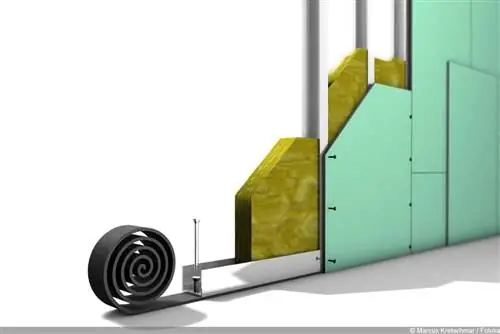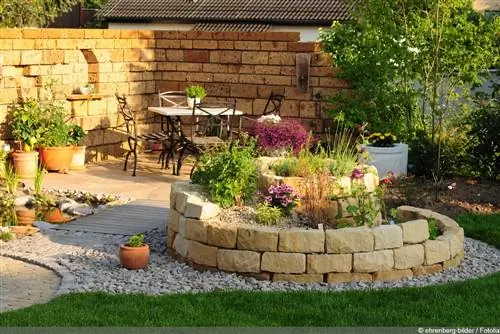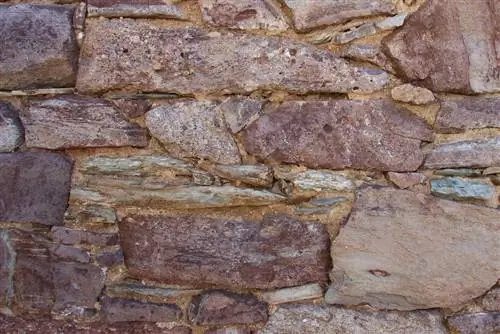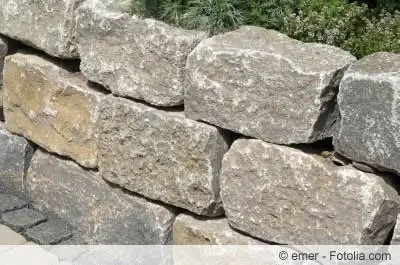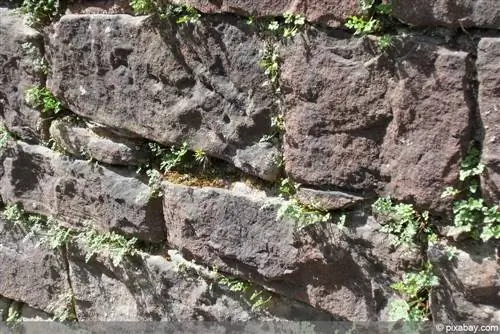- Author admin [email protected].
- Public 2023-12-17 03:39.
- Last modified 2025-06-01 06:48.
Even in ancient times, the Romans knew how to use the decorative sandstone correctly, so that some of the buildings, arenas and aqueducts built back then are still standing and can be admired today. Sandstone is a very popular product, for example for building a wall in the home garden. But there are a few things that need to be taken into account when building walls so that the work lasts for a long time. Which additional materials are needed and how to build bricks is explained in the following article.
Sandstone - Definition
Sandstone is a very soft rock, which is therefore easy to process. A sandstone wall in the garden can be a true biotope and therefore very ecologically valuable. However, this is more likely to be the case with dry stone walls. The sandstone can be installed in two variants:
- as drywall
- the stones are placed on top of each other without binding agents
- are tilted together so that they hold
- Sandstones are bricked
- Installed using mortar or glue
- the right substance is important
- otherwise the wall couldn't last long
However, both techniques basically involve a natural stone wall that fits well into natural gardens.
Tip:
Before a wall is built, the country's building laws must also be observed in your own garden. This can vary from community to community. But from a height of two meters, a static calculation must be carried out before construction and the construction must be approved. This also applies to sandstone walls.
Tools and materials
Before building the sandstone wall, whether as a dry stone wall or attached with mortar, the appropriate tools and materials used should be provided. Then the work gets done quicker. This requires:
- Guidelines for building the foundation
- Spade
- shaker
- Spirit level
- rubber hammer
- Gravel and sand
- Concrete for foundation of brick sandstone
- Mineral mixture and building sand for drywall foundation
- Lime mortar
Tip:
As a rule, not every garden shed has a vibrator. But this is needed to secure the foundation. However, a purchase is unnecessary, as vibrators can also be rented on a daily basis from well-stocked retailers or hardware stores.
Foundation for grouted sandstone wall

If a sandstone wall is grouted during construction, it requires a concrete foundation. To ensure the stability of the future wall, the foundation should be proceeded as follows:
- Dig a trench
- at least 40 cm deep, better up to 80 cm
- slightly wider than the desired wall width
- fill in a five to ten centimeter layer of sand
- solidify well
- Use shaker
- add a five to ten centimeter layer of gravel over this
- mash and solidify just as well
- there will be at least 20 centimeters of concrete on this
- Let it dry thoroughly before building the walls
Tip:
So that the foundation and the future wall are drawn straight, a guide line should be used before digging. To do this, two small sticks are inserted into the ground at both ends of the foundation and a string is attached between them. The foundation is now being dug along this route.
Matching mortar
The right joint compound is important when building a sandstone wall. There are many tips circulating on the internet, but not all of them are good or correct. Natural stone mortar can certainly be used for a conventional natural stone wall, but this is not suitable for sandstone walls. Therefore, when choosing the right mortar for the sandstone wall, you should pay particular attention to the following:
- Sandstone is a sedimentary rock consisting of 50% sand
- has a layered structure
- therefore sandstone is very soft
- Mortar and grout should always be softer than the stone
- Use NHL lime for grouting
- This is hydraulic, natural air lime
- is available in different grit sizes
- Use 4 mm grit to set the stones
- for later smooth grouting, a grain size between 1 mm and 2 mm
If the right mortar is used in the form of NHL lime, this gives the sandstone long-term stability, as it is an even softer mass than sandstone.
Tip:
Trass mortar is often recommended as a joint mixture for sandstone walls. However, this is unsuitable as it promotes the weathering of sandstone. Exposed trass mortar surfaces absorb water and transfer it into the sandstone.
Construction of the sandstone wall
Once the foundation has been laid and the right mortar has been obtained, construction of the sandstone wall can begin. In contrast to dry stone walls, when buying sandstones, you should make sure that they all have the same shape and size. The stones can be purchased standardized from well-stocked specialist retailers. Various standard dimensions are offered here, which are easier to stack and joint. The sandstone wall is then constructed as follows:
- Tighten the guide line straight
- apply a three centimeter layer of mortar on the foundation
- laying the first row of sandstone
- align with the guideline
- tapping stones with a rubber mallet
- so even small differences in height are compensated
- check with spirit level
- Fill butt joints with mortar
- put mortar on the first row of stones
- continue with the next row of sandstones
The first steps are now repeated until the wall has reached the desired height. For a better look and, above all, better stability, it is important to ensure that the stones are offset in each row. The butt joints should not be directly on top of each other. It looks nice when the joints are always in the middle of the other sandstones.
Tip:
In well-stocked stores there is appropriate advice on which stones are suitable for the desired look. A distinction is made primarily between grouted and natural looks.
Foundation for dry stone wall
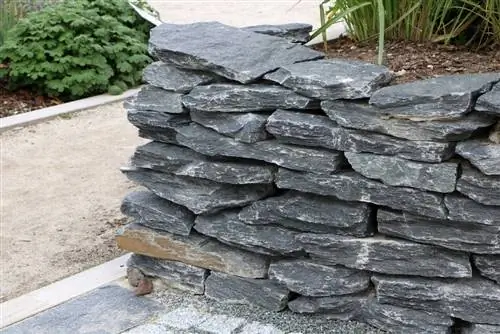
The foundation for building a natural dry stone wall is less complex. The procedure is as follows:
- dig about forty centimeters deep
- slightly wider than the later wall
- Fill mineral mixture
- should be filled about thirty centimeters high
- building sand is poured onto this
The first layer of sandstone for the dry stone wall is pressed firmly into the building sand so that it is firmly anchored in the sand. The stones can also be tapped into the sand layer with a rubber mallet.
Construction of the dry stone wall
Since the dry stone wall is a natural stone wall in which animals should also find a place in the gaps, stones that are not completely flat and uniform are usually used for construction. These are simply placed on top of each other. Earth can also be applied between the individual layers. This supports later plant growth. If there are very large gaps between the individual quarry stones, then these are filled with small fragments of stone. So they are under tension and hold each other. A dry stone wall offers the following advantages in particular:
- adapts to the natural garden
- own biotope for many animals and plants
- Planting ensures more stability
Tip:
If you want to offer many local animals a natural habitat in your garden, you should choose to build a dry stone wall. Second beneficial side effect, construction is quicker because neither concrete nor mortar has to be used.


